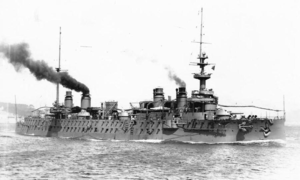French cruiser Sully
 Sister ship Gloire in 1913
| |
| History | |
|---|---|
| Name | Sully |
| Namesake | Maximilien de Béthune, Duke of Sully |
| Builder | Forges et Chantiers de la Méditerranée, La Seyne |
| Laid down | 24 May 1899 |
| Launched | 4 June 1901 |
| Completed | June 1904 |
| Fate | Ran aground and wrecked, 7 February 1905 |
| General characteristics | |
| Class and type | Template:Sclass- armored cruiser |
| Displacement | 10,014 t (9,856 long tons) |
| Length | 139.8 m (458 ft 8 in) |
| Beam | 20.2 m (66 ft 3 in) |
| Draft | 7.7 m (25 ft) |
| Installed power |
|
| Propulsion | 3 shafts, 3 Triple-expansion steam engines |
| Speed | 21 knots (39 km/h; 24 mph) |
| Range | 12,000 nautical miles (22,000 km; 14,000 mi) at 10 knots (19 km/h; 12 mph) |
| Complement | 612 |
| Armament |
|
| Armor |
|
The French cruiser Sully was an armored cruiser of the Template:Sclass- that was built for the French Navy in the early 1900s. She was named in honor of Maximilien de Béthune, Duke of Sully, trusted minister of King Henry IV.[1] The ship struck a rock in Hạ Long Bay, French Indochina in 1905, only eight months after she was completed, and was a total loss.
Design and description

The Gloire-class ships were designed as enlarged and improved versions of the Template:Sclass- armored cruisers by Emile Bertin. Her crew numbered 612 officers and men.[2] The ship measured 139.8 meters (458 ft 8 in) overall, with a beam of 20.2 meters (66 ft 3 in). Sully had a draft of 7.7 meters (25 ft 3 in)[3] and displaced 10,014 metric tons (9,856 long tons).[2]
Sully had three propeller shafts, each powered by one vertical triple-expansion steam engine, which were rated at a total of 20,500 indicated horsepower (15,300 kW). Twenty-four Belleville water-tube boilers provided steam for her engines. She had a designed speed of 21.5 knots (39.8 km/h; 24.7 mph).[3] She carried up to 1,590 long tons (1,620 t) of coal[2] and could steam for 12,000 nautical miles (22,000 km; 14,000 mi) at a speed of 10 knots (19 km/h; 12 mph).[3]
Sully's main armament consisted of two 194 mm (7.6 in) guns mounted in single-gun turrets fore and aft. Her intermediate armament was eight 164 mm (6.5 in) guns. Four of these were in single gun turrets on the sides of the ship and the other four were in casemates. For anti-torpedo boat defense, she carried six 100 mm (3.9 in) guns in casemates and eighteen 47 mm (1.9 in) Hotchkiss guns. She was also armed with five 450-millimeter (18 in) torpedo tubes; two of these were submerged and the others were above water.[2]
The waterline armored belt of the Gloire-class ships was 170 millimeters (6.7 in) thick amidships and tapered to 106 millimeters (4.2 in) towards the bow and stern. Above the main belt was another belt, 127 millimeters (5 in) thick that also tapered to 106 mm at the ends of the ship.[4] The main gun turrets were protected by 173 millimeters (6.8 in)[3] of armor and the intermediate turrets by 120 millimeters (4.7 in). The flat part of the lower armored deck was 45 millimeters (1.8 in), but increased to 64 millimeters (2.5 in) as it sloped down to the sides of the ship.[4]
Service
Sully was laid down at the Forges et Chantiers de la Méditerranée shipyard in La Seyne on 24 May 1899 and launched on 4 June 1901. The ship was completed in June 1904 and sent to French Indochina for her first commission.[1] On 7 February 1905 Sully struck a rock in Hạ Long Bay; her crew was not injured. Her guns and equipment were salvaged, but the ship broke in two and was abandoned as a total loss.[4]
Notes
References
- "French Armored Cruiser Sully". Warship International. V (4). Toledo, Ohio: Naval Records Club: 324–26. 1968. ISSN 0043-0374.
- Gardiner, Robert, ed. (1979). Conway's All the World's Fighting Ships 1860–1905. Greenwich: Conway Maritime Press. ISBN 0-8317-0302-4.
- Silverstone, Paul H. (1984). Directory of the World's Capital Ships. New York: Hippocrene Books. ISBN 0-88254-979-0.
External links
